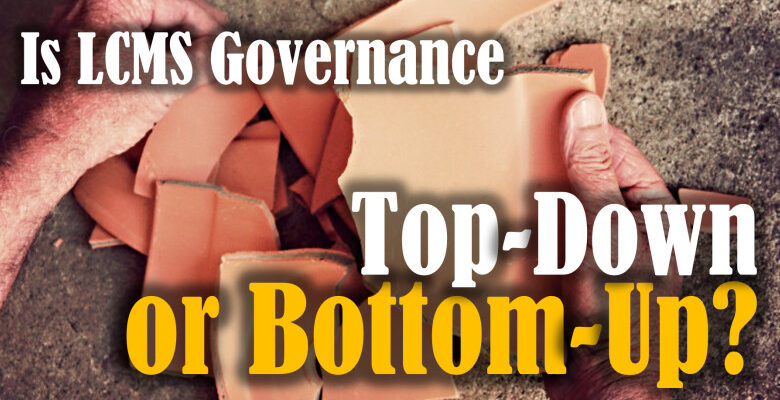From the beginning of our Synod, we struggled with big questions of relationships and governance polity. Should the laity have authority over the clergy? Should the clergy have authority over the laity? Should a “bishop” have authority over the congregations?
Questions like those formed the chaotic beginning of the Lutheran Church – Missouri Synod! This republished essay will follow the decisions our Synod has made from its beginnings with quotes from C.F.W. Walther and our own LCMS Constitution.
Top-down or bottom-up? What is right-side up? Read the full guest essay here or the Executive Summary that follows.
Executive Summary
Our history in the LCMS traces the change of hearts and minds on this issue of church polity. In the beginning, the Saxon immigrants to the United States chose a top-down polity. They established Pastor Martin Stephan as the “bishop,” an office that required complete obedience in all matters, secular and spiritual. His moral failure, however, showed our fathers in the fledgling church just how dangerous that could be. As a result of this experience, the Lutheran Saxon colonists under the leadership of Dr. C.F.W. Walther (who would later become the first President of the Synod in 1847) changed their minds on this issue. They turned the polity of the LCMS upside-down.
C.F.W. Walther’s Views
Walther’s view of congregational polity prevailed in the founding of the Synod in 1847. A bottom-up (“congregational”) polity adopted by the Synod was articulated by Walther in his 1848 Presidential Address:
“According to our constitution, we have no right to formulate decrees, to pass laws and regulations and to make a judicial decision, to which our congregations would have to submit unconditionally, in any matter involving the imposing of something upon them… According to our constitution we are not above our congregations, but in them and at their side.” (Emphasis added)
In describing our bottom-up organization, Walther also said:
“We can hardly consider any other constitution as the most salutary but one under which the congregations are free to govern themselves….we ask nothing unconditionally of our congregations except submission to the Word.” (Emphasis added)
So what does the LCMS Constitution say? Who has the authority?
The Constitution answers the governance question unequivocally:
“In its relation to its members the Synod is not an ecclesiastical government exercising legislative or coercive powers, and with respect to the individual congregation’s right of self-government it is but an advisory body. (Constitution Article VII, Emphasis added)
Advisory Bodies Advise
As an advisory servant, Synod has only the capacity to advise, encourage, teach, and support the congregations. Just as a pastor of a congregation, the Synod has no controlling authority over its members — nor should it.
The Word Is God’s Ultimate Top-Down Power and Authority Among Us
Above all, what in fact is top-down is the Word of God, its power and authority. The members of the Synod are committed to the Scriptures as the final authority (top-down). Our Constitution says it this way:
“All matters of doctrine and conscience shall be decided only by the Word of God. All other matters shall be decided by a majority vote” (Constitution, Article VIII, C).
Since God’s Word alone has binding force, no Synod legislation and no resolution in and of itself, no control, no domination, no force, no fiat or coercion can bind us. Synod is only advisory (Article VII).
However, the Word of God binds congregations. God’s Word is the ultimate top-down power and authority.
We Must Be Vigilant, For Some Among Us Seek Control
Under the impact of the top-down Word of God, we can be a bottom-up Synod “walking together!” We must reject any top-down governance behavior and actions of the Synod conventions, the administration, and the officers of the Synod.
Centralization of power? Right-side up? Top-down or bottom-up? The historic, Scriptural and Confessional answer is clear. Our congregational polity means a bottom-up polity – and only the top-down authority of the Word of God!
It’s true. It’s all about Our Congregations — Our Synod.
Click This Link for the Full Essay in PDF format

